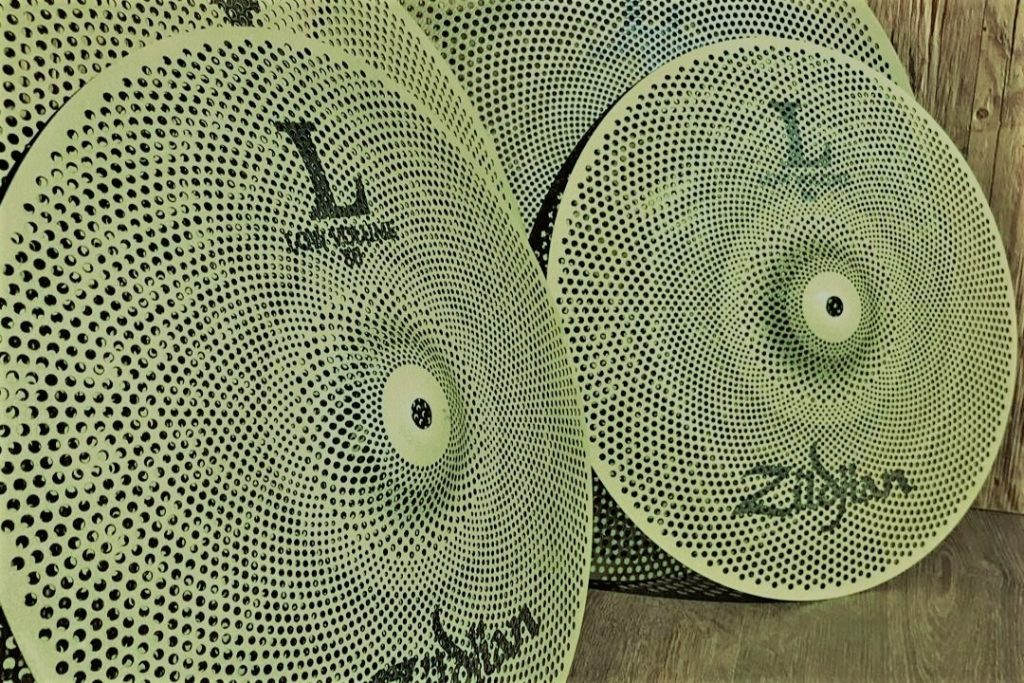Why low volume cymbals?
The drums are loud, and cymbals are probably even louder. Luckily for us, we can now buy low volume cymbals.
As a drummer with 20+ years of experience, it hurts to admit I’ve had a mild case of tinnitus for the last five.
In case you’ve never heard of tinnitus, according to Wikipedia:
“Tinnitus is the perception of sound when no corresponding external sound is present. While often described as a ringing, it may also sound like a clicking, buzzing, hiss, or roaring.”
I’ve also been going to music festivals regularly, so it was pretty common for me to have some type of ringing for a few hours after a loud show.
That’s obviously a sign that something is wrong, and you shouldn’t ignore it.
However, when the ringing is non-stop, and for drummers, that’s unfortunately really common due to the nature of our instrument, that’s where it’s probably too late to reverse it.
It’s not fun! But we can definitely avoid it if we really want to.
Thankfully for us, in the last decade, we saw a rise in low volume cymbals popularity. We can now find them in most popular brands catalogs, but also in lesser-known ones, even for a pretty reasonable price.
What’s the definition of a Low Volume Cymbal?
Low Volume Cymbals are designed to feel like normal ones, while drastically reducing the volume.
That makes them perfect for practice spaces, small teaching rooms, acoustic shows, avoiding annoying your neighbors and the most important thing, protecting your hearing!
When using low volume cymbals combined with mesh drum heads, you don’t need to use extreme isolation headphones, isolate your practice room walls or play with obnoxiously loud music.
In this article I’ll focus on premium low volume cymbals, as well as budget ones, since nowadays there’s an option for every wallet.
Additionally, I’ll also talk about my personal experience, including my current low volume practice setup and what I think about if after two years of regular use.
After testing them, and owning some, here are my picks for the best low volume cymbals:
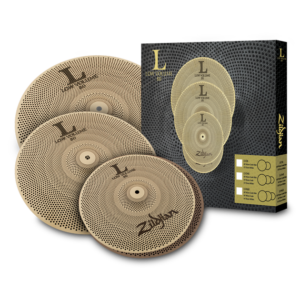 Specifications:
Specifications:
- Sound: (up to) 80% Quieter
- Material: Brass
- Finish: Matte
They are usually available in three different packs:
- 38 Box Set: 13″ Low Volume Hi-Hat / 18″ Low Volume Crash/Ride
- 348 Box Set: 13″ Low Volume Hi-Hat / 14″ Low Volume Crash / 18″ Low Volume Crash/Ride
- 468 Box Set: 14″ Low Volume Hi-Hat / 16″ Low Volume Crash / 18″ Low Volume Crash/Ride
On top of that, you can also improve your set with individual cymbals, like splashes and chinas.
These were the first low volume cymbals I tried a few years ago, and the ones that made me realize that they are more than just a marketing shenanigan.
They really feel like regular cymbals, even though they are way lighter. L80s are articulate and responsive with sticks, brushes and mallets so nothing goes unpracticed.
The Hi-hats are the biggest winner here. You can really tell the difference between them open, closed and half-open, which is way more than I was expecting.
They are also way faster than regular Hats, considering the lower weight. That shouldn’t bother you too much.
The crashes (in case you own more than one) have a real distinct difference in pitch which adds color to your cymbal set, and amazing low sustains, perfect for low volume scenarios.
The ride is decent, besides the bell (the bulge in the center of the cymbal).
It doesn’t have the loud, bright, less sustained effect someone would expect. I think that’s a “problem” that will always remain in low volume rides due to the nature of the materials and production.
The volume is indeed way lower than the regular cymbals. I wouldn’t say 80%, that’s a bit of an exaggeration. 50-70% seems way more plausible to me.
My two years of experience
I usually play my acoustic drum set with isolation headphones and the volume of the music between 80 and 100 on my laptop.
On the other hand, with low volume cymbals (and mesh heads), I use the same laptop to play along some music, and the volume is usually between 8 and 10. Yes, only 10% of the original volume.
If you decide to pick up the L80s, Zildjian also advises:
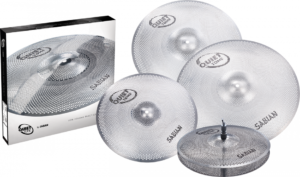 Specifications:
Specifications:
- Sound: (up to) 80% Quieter
- Material: Stainless Steel
- Finish: Brilliant
They are currently sold in three different packs:
- QTPC501 Set: 13” Hi-Hats / 18” Crash/Ride
- QTPC503 Set: 14” Hi-Hats / 16” Crash / 20” Ride
- QTPC504 Set: 14” Hi-Hats / 16” Crash / 18” Crash / 20” Ride
Sabian has been one of, if not the biggest Zildjian competitor over the years and the low volume cymbal packs aren’t any different.
The three packs from both Zildjian and Sabian are similar, with a small but really important difference: some of the Sabian packs include a 20” ride.
The volume is also pretty close to Zildjian’s, so pretty low, but I could honestly tell they are a little bit louder in comparison and obviously not 80% quieter either.
Since Quiet Tones are “louder” than L80s, they seem like a great fit for an acoustic show, while for practicing in an apartment, L80s look like a much better fit.
They respond like real cymbals too, so that’s nice, but also expected considering that’s what they aim for.
I could also notice that the Quiet Tones sound brighter with a little bit more sustain while the L80s have a more defined stick noise.
The bigger bells on the Sabians are another positive, since one of my complaints about the L80s was the fact that the ride bell didn’t sound like anything you would expect from a bell.
Don’t get me wrong, neither does the Sabian one, but it is indeed closer to a regular bell.
Another positive about the Sabians is the material. Since the Quiet Tones are made with stainless steel, I expect them to, at least on paper, last longer than the L80s brass.
Something important we shouldn’t ignore is the price tag: Sabian takes the cake in that category, since they are considerably cheaper than the Zildjians while offering a pretty similar experience.
After all the positives, let’s talk about the negatives
Sabian’s catalogue, when it comes to low volume cymbals, is shockingly mediocre (compared to Zildjian’s at least).
While Zildjian’s catalogue includes chinas and splashes to spice up your setup, Sabian’s can be summarized with the three cymbal packs mentioned above and nothing else. That’s a big no-no for me.
Some call it a futuristic look, and even though looks aren’t a top priority, I also think the Quiet Tones look really bad, compared to the L80s sophisticated look, but that might be my personal preference.
In the end, it all comes down to what you prioritize, and even though the Quite Tones are really well made and a serious contender for the best low volume cymbals, I would pick the Zildjians in a heartbeat.
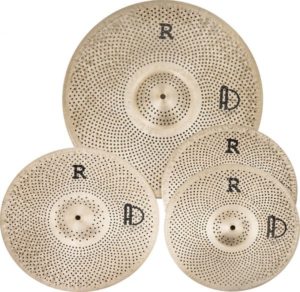 Specifications:
Specifications:
- Sound: (up to) 75% Quieter
- Material: B20 Bronze
- Finish: Brilliant
The packs available at the moment are:
- Regular R Series Low Noise: 14″ Hi-Hat / 16″ Crash / 20″ Ride / Free cymbal bag
- Flat R Low Noise Set (X-tra Silent): 14″ Hi-Hat / 16″ Crash / 20″ Ride / Free cymbal bag
- Natural R Low Noise (dry): 14″ Hi-Hat / 16″ Crash / 20″ Ride / Free cymbal bag
Agean is a fairly unknown brand, at least compared to the veterans at Zildjian and Sabian.
However, that shouldn’t influence your decision, and I will tell you why. Let’s start with the positives:
Unlike the alternatives that use a random alloy, the R Series Low Noise cymbals are made with B20 Bronze, the same material used in most professional cymbals we all know and love.
To make things even better, Agean lets you choose between the regular series, the flat with no bells one and the dry cymbal pack. That gives you more alternatives than any of the established brands.
The biggest surprise to me was the fact that they are handmade in turkey, and that may as well be reflected in the price.
If you ignore the holes, they look and feel the closest to the regular cymbals, when it comes to low volume ones. I assume the B20 Bronze used is one of, if not the biggest reason.
Thankfully, they also offer individual cymbals like splashes and chinas to diversify your cymbal set (You heard that, Sabian?!).
I mostly use Thin or Medium-Thin cymbals, so the Agean low noise crashes were obviously one of my favorites, since they sound like the cymbals I usually use, with half the volume.
Enough praising, let’s move to the negative aspects of the Ageans
They are definitely louder than most low volume cymbals. Not as loud as regular cymbals, but for sure in-between regular and low volume ones, like the L80s.
That basically means the Ageans shouldn’t be your pick if you really want a “silent” practice or teaching setup, but they should definitely be (or at least considered) if what you’re looking for is a cymbal setup for acoustic/low volume gigs.
The biggest downside of them all is, without a doubt, their price.
They cost as much as some of the professional cymbal packs, like Sabian AAX or Zildjian A Custom, but the fact that they are made with B20 Bronze may justify that.
If money isn’t a problem and you aren’t looking for a near-silent cymbal pack, but more of a lower volume one, Agean should be taken into serious consideration.
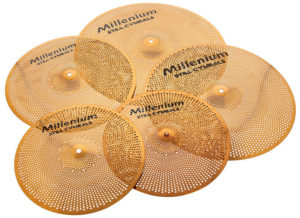 Specifications:
Specifications:
- Sound: (up to) 80% Quieter
- Material: Nickel
- Finish: Brilliant
First, let’s start by talking about the Millenium brand for those of you who’ve never heard of them.
Millenium as a business started way back in 1994, as Thomann’s (the German music store) own brand.
They sell everything related to drums, from basic hardware to e-drums or cymbals.
All the products sold under Millenium are made by well-known manufacturers who also produce equipment for many other famous brands. In other words, they don’t produce anything themselves.
Since Thomann imports those products straight from the factory, without the need of a middleman or distributors, they are usually sold for a relatively cheap price. That’s why I decided to include them in this article.
Now that I’ve talked a bit about the history of Millenium, let’s review the Still Series pack.
As you may have noticed, I didn’t list the cymbal packs available, because there’s only one. Well, two, since they are sold in both silver and a golden-type of finish.
The pack itself includes: 14″ Hi-hat / 16″ Crash / 18″ Crash / 20″ Ride.
Just the fact that they included a 20” ride, plus a 16” and 18” crash makes them a better choice than the Zildjian L80s in that regard. But there’s more to it than what a cymbal pack includes.
Still Series is probably on par with the L80s and the Quiet Tones in terms of volume, and definitely lower than the R Series Low Noise.
When it comes to the sound itself, they’re probably the worst out of the four, with the Hi-Hats being the biggest loser thanks to their annoying high frequencies.
The good thing is, good sound isn’t what you’re looking for when you’re shopping for a low volume cymbal pack (unless you’re eyeing some acoustic gigs, then just pick the Agean ones).
Another great thing about the Still Series is the fact that you can improve your set up with some splashes, chinas and even a 13” Hi-Hat. Sabian are the only ones that missed the memo, it seems.
And with all those positives, I saved the best for last: the price.
Millenium Still Series in the silver finish is usually sold for around $130 while the golden one is $150.
Compared to the QTPC504 pack from Sabian, which is the only one that offers the same four cymbals and cymbal sizes, it costs only 35% of Sabian’s price.
Yes, you read it right. It costs almost a third, while not being, a third of the quality. It’s honestly a great price/quality ratio.
That’s what made it for me. I own a Millenium Still Series pack in gold finish and paired with some mesh heads, it improved my practice quite a lot since I can now practice whenever without feeling like I am annoying half of my city.
Plus, as someone with a mild case of tinnitus, it’s great to know drumming won’t damage my hears as much since drums are not as loud and I now play with music at 10% volume instead of almost 100%.
Durability shouldn’t worry you either, since I’ve owned mine for close to two years, and they look and feel as good as new, as you can see from my current practice setup:
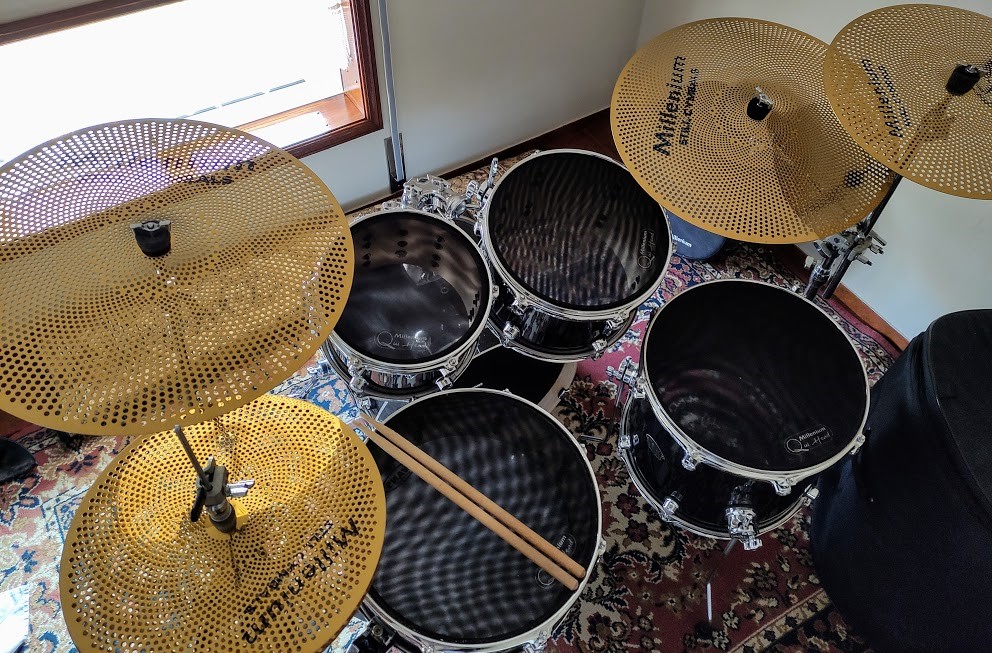
Conclusion
To wrap it up, if you’re like me and don’t really care about logos or the best sounding low volume cymbals, the Millenium Still series should be everything you’re looking for.
In case you’re only looking for quieter cymbals, but not really “silent”, to play a few acoustic gigs, then the Agean R Series Low Noise should be your go-to cymbals.
If for some reason you prefer more well-established brands and therefore better build quality and sometimes sound, Zildjian L80s are a great option considering they also sell individual cymbals like chinas and splashes.
In my opinion, Sabian Quiet Tones should only be the ones you end up buying if for some reason you really want the experience of well-known brands and you can’t find/hate Zildjian.
All in all, those are without a doubt the four best low volume cymbal packs you can buy as of 2021, and thankfully there’s something for every wallet or taste so there’s absolutely no excuse to not practice your rudiments on something more exciting than a practice pad.

